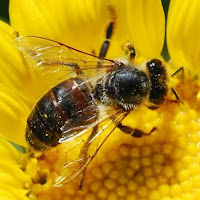For the past few years, the hub-cake and I have been interested in raising bees. We've watched/read several things about Colony Collapse Disorder and the mysterious disappearance of honeybees in general and have always felt that one way to "give back" (even in a tiny way) would be to raise some bees. It would be great to get some honey, but our main purpose is similar to the reason why you put a bird feeder out. You want to help nature in some small way and it is interesting to watch different birds flit and fly around your backyard. Lately I've been reading more about the biology of bees and just how those bee hives work on the inside and it's pretty addicting stuff. Bees are insanely fascinating. They have such specialized and important jobs and every little detail is attended to within a hive. They are, however, fairly fragile. A poorly producing queen can throw a wrench in the works, too many drones, not enough drones, a bad year for flowers, a tough winter, a wet summer, and many other variables can all affect the health of a single colony. One faulty "part" and the whole thing may fall apart.

Here are some bee fun facts:
- Bees pollinate about 1/3 of our food supply (just one reason why you should not consider this venture crazy)
- Honey bees can travel up to two miles away from their hive while collecting pollen.
- Honey bees navigate with an internal "GPS" similar to that of birds (they work like magnets)
- Honey bees are cold blooded and can handle weather fluctuations pretty well.
- Bees survive the winter by eating the honey they've stored. If they have a good summer, they'll produce excess honey (which we can then harvest and eat!)
- Changing queens will change the personality and routine of the hive (just as it would in a human society)
- A colony of bees consists of 20,000-60,000 honeybees and one queen. Worker honey bees are female, live for about 6 weeks and do all the work. Males are for mating and, unfortunately, are prone to mites.
Okay someday I might write a post about all of the different roles bees fill in the hive. It's absolutely amazing.
Well Chris and I went to bee school and spent the first hour feeling completely overwhelmed and staring blankly at the power point in front of us. Actually, I can only speak for myself. It's entirely possible Chris was not as confused as me... but I doubt it. Then a second speaker came up and began his presentations with "Getting Stung." Ah yes, this is more my pace! Long story short, bees are a tricky business and they might just die the very first winter. This wouldn't be such a big deal if a pack of bees wasn't $80-$120. That is an investment I can make once (after a month of saving), but not one I'd like to make year after year. And they recommend you start with two colonies!
When purchasing bees, you have two choices: packages or nucs. Packages come from Florida or Alabama and run about $80. If you order a package you get 3 pounds (about 10,000) bees delivered to your door! This includes a queen as well. Then you dump them in the bee box and hope they all figure out what to do.
Nucs are colonies that are already beginning. You get the comb already attached to some frames, the bees have already stored some honey, and integrated the queen. These you'd buy locally so they are climatized and also run $120.
Professional beekeepers say that you can be equally successful, but I feel like the nucs sound like a better option. They cost a bit more, but to me it seems smarter to start with a partially formed colony. So that's what we ordered and we pick them up mid-May!
You also need a bee box. There are many parts to a bee box:

Bees build their colonies up so the longer the colony survives the more boxes you would stack on top. The very bottom one is where the bees are and the one above is where they store honey. Any additional boxes above that are surplus honey. If you take too much honey then you have to offer the bees supplemental food throughout the winter. Phew... but that's not all! if you want liquid honey you have to buy (or access) an extractor (they run about $200-$300). You can do it the old-fashioned way, but one of my co-workers has an extractor and said she would share it!
There are things like bee veils and smokers to keep from getting stung, but I have a feeling that bee sting posts will exist in my future!
This is seriously only the beginning. Who would have thought it would "bee" so complicated? (I had to work in one bee joke!). I'm really excited to start and a little nervous. And while this post makes it sound like I know a lot about bees, I assure you that when they arrive I will put them in the box and then go, "holy shit, now what?"

1 comment:
Fascinating! Looking forward to more posts!
Dawn
Stanwood, MI
Post a Comment